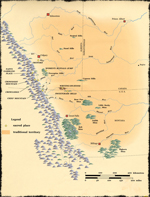| Social Studies | Close this window |
 |
Return to Making Connections to Land, People and Places |  |
Love Thy Neighbour: Repatriating Precarious Blackfoot Sites
Authors: Cynthia M. Chambers & Narcisse J. Blood
|
IntroductionThis paper explores the question of responsibility for the care of significant Blackfoot (Siksikáítapiiksi) sites particularly in the province of present-day Alberta.i Traditional Blackfoot territory is described and events that eroded Siksikáítapiiksi access to, and thus relationship with, all the land in their territory is related. We give examples of significant Blackfoot sites and recount the forces that have destroyed many of them, including the pressures that urban and industrial development place on the remaining sites. This chapter outlines current attempts to include Blackfoot perspectives in the provincial mandate to preserve and protect heritage sites. The notion of repatriation, which is commonly understood to mean the return of ceremonial objects, is offered as a model for authentic participation of Blackfoot in protecting and preserving these sites. Repatriation, as an idea and a practice, acknowledges the Siksikáítapiiksi view that places are animate beings with whom humans live in relationship. Like any interdependent relationship, the one between people and the places that sustain them is nurtured through unimpeded access, continued use and ceremonies of renewal such as visiting and exchanging of gifts. Figure 1: Map of traditional Blackfoot territory. Nitáówahsinnaan or Blackfoot territory extends north to Apatohsoo omáhkataan (“north big river” which was re-named the North Saskatchewan) and south to Ponokáásisahtaan (“elk river” which was re-named the Yellowstone). The people lived from the eastern slopes of the Mistákistsi (the backbone of the world which was re-named the Rocky Mountains) to the reaches of present-day Saskatchewan,i Ómahksspatsiko (the Sand Hills), where people go after death (Blackfoot Gallery Committee, 2001) and Awai’skiimmiiko (re-named the Cypress Hills), where the people hunted and gathered resources such as lodge poles, pine needles and berries. Nitáówahsinnoon covered over half of present-day Alberta, most of Montana and parts of Saskatchewan. And while the Niitsítapiiksi (in this context, the Blackfoot) shared the land with all other ksahkomitapiksi or earth beings (plants, rocks, and animals), they shared the cosmos with the spomitapííksi or above beings (spiritual beings, celestial beings, and birds), and the soyíítapiksi or under-water beings (fish, amphibians, reptiles, water birds and mammals) (Blackfoot Gallery Committee, 2001). Many of the stories and ceremonies of Blackfoot-speaking peoples originate in the sky, and many ceremonies revolve around bundles, which contain parts of animals and plants from all of the realms.ii These bundles and their contents stand in for the extended network of animate, inspirited kin from all the realms. The bundles serve to remind human beings that their survival depends upon alliances formed with other beings in times past, social contracts still in force. The origins of these kinship ties and the ongoing web of reciprocities and interdependent responsibilities they evoke are recalled through song and stories (Ingold, 2000). Through ceremonies and ritual, as well as through more mundane practices of visiting and feeding, these alliances are continually renewed (Heavy Head, 2005). The ceremonies of renewal were not simple rituals of faith slavishly adhered to by a primitive, animistic people. The ability of Siksikáítapiiksi to live well in kitáóowahsinnoon iii depended on deep, extensive, intimate knowledge about all realms of the environment. This knowledge was both ancient and timeless, acquired by living and attending to kitáóowahsinnoon, with all of one’s senses and aspects of being. This knowledge also came to people through papáítapiksi or dream beings, and through vision quests. Knowledge gained in all these ways was transferred from generation to generation through everyday activities, as well as, through ceremonies. At present, it would be true to say that Siksikáítapiiksi do not have the extensive geographical and ecological knowledge of their territory they possessed a generation or two ago. People may wonder why is this so? If the land was important to the Siksikáítapiiksi why did they allow these relationships to deteriorate and the knowledge to lapse? |
Next Section: A Story 



